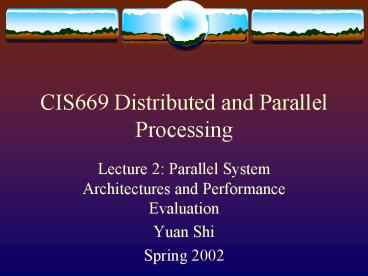CIS669 Distributed and Parallel Processing - PowerPoint PPT Presentation
1 / 17
Title:
CIS669 Distributed and Parallel Processing
Description:
Less degree of parallelism (do fewer things at the same time) ... We need to calculate proper parallelism BEFORE implementing a software/hardware solution. ... – PowerPoint PPT presentation
Number of Views:46
Avg rating:3.0/5.0
Title: CIS669 Distributed and Parallel Processing
1
CIS669 Distributed and Parallel Processing
- Lecture 2 Parallel System Architectures and
Performance Evaluation - Yuan Shi
- Spring 2002
2
Parallel System Architectures
- Lacking the dignity of a proper discipline,
it was an orphan in the world of knowledge. The
subject became a rag-bag filled with odds and
ends of knowledge and pseudo-knowledge, of
Biblical dogmas, traveler's tales, and mythical
imaginings Boo83, p.100, textbookp.15.
3
Where are the flies?
- Computers can be built in many different ways for
many different applications. Finding a common
criteria to compare architectures is VERY
difficult. - Once built, computational performance (speed)
varies greatly from applications to applications.
It is equally difficult to have a common criteria
to measure the goodness of a given
architecture. - Finally, programming difficulties vary from
architecture to architecture. Each parallel
programming environment dictates a specific
programming style that is typically more complex
than the serial programming interface.
4
Most Recent Examples
- Cilk (http//supertech.lcs.mit.edu/cilk/) MIT
- Passages (http//www.cis.udel.edu/hiper/hiperspac
e/projects/gary.htm) Udel - EARTH (http//www.capsl.udel.edu/CURRENTPROJ/EARTH
/) Udel
5
First Battle Fine v.s. Coarse Grain Parallelism
- Fine grain. Pros
- Large degree of parallelism (do many things at
one time) - Find grain Cons
- Large communication overhead
- Difficult programming model
- Less reliable
6
Coarse Grain Parallelism
- Coarse Grain Pros
- Ease of programming
- More reliable
- Less communication overhead
- Coarse Grain Cons
- Less degree of parallelism (do fewer things at
the same time)
7
Question How to determine the best degree of
parallelism?
- Timing Models
- Timing Model is a method for calculating the
performance of running programs on any hardware
architecture. - Timing Model can also be used to calculate the
scalability of the running programs and
architecture. Because, scalability is hardware
and application dependent.
8
Introduction to Timing Models
- Time Complexity T(n) O(f(n)) gt The time to
run a program on n-sized input is above-bounded
by f(n). It really means that it will take no
more than f(n) steps to compute n inputs. - Timing Models
- Single Processor Ts(n) f(n)/W gt The time to
run a program is approximately equal to the
estimated algorithmic steps/single processor
power W (algorithmic steps per second).
9
Timing Model for Multiprocessors
- T(n,p) TCompute TCommunication TIO
f(n)/pW g(n,p)/? k(n,p)/B - T(n,p) estimated running time for size n and p
processors. - g(n,p) estimated communication volume (bytes)
- k(n,p) estimated IO volume(bytes)
- W single processor power in algorithmic
steps/second - ? interconnection network speed in bytes/second
- B IO speed in bytes/second
10
How to obtain values for W, ? and B?
- Each parameter represents a RANGE of values.
- Each parameter can be calibrated using
computational experiments. - Ts(n)f(n)/W can be used to derive Wf(n)/Ts(n).
- Set p2, T(n,p) can be used to derive
?g(n,p)/(Tp(n)-f(n)/pW) by removing the IO part
(easily done). - Instrumenting the sequential source code can
derive k(n,p) and B easily.
11
Practical Example
- Matrix Multiplication A x B gt C.
- Assumptions
- Each matrix is of n x n elements.
- Each element is double precision (8 bytes).
- Timing Model (using O(n3) algorithm)
- Tp(n)n3/pWg(n)/ ?k(n)/B
- Ignoring IO to simplify Tp(n) n3/pWg(n)/ ?
- Observation If pn2, the system could be VERY
FAST since each dot-product is computed on an
independent processor in parallel with others.
Degree of parallelism n2 (fine grain).
12
Quantitative Arguments for Coarse Grain
Parallelism
- What about g(n,p)? A dot-product requires one row
of A and one column of B gtminimal 2 x 8 x n
16n bytes per processor or 16n3 bytes transmitted
across the network. - Comparing g(n,p)/ ? with f(n)/W, f(n)/W should
be smaller (faster) since W(in GHZ) is typically
gtgt ?(in MBps).
P1
P1
P1
P1
Interconnection Network
P1
P1
P1
P1
Px
13
Example II Massively Parallel Potentials
- Fractal calculation involves solving massively
many equations in complex plane in order to
produce the color indices (number of iterations
until diverging outside of a pre-defined box
(http//aleph0.clarku.edu/djoyce/julia/explorer.h
tml) to make a striking look image. - Ref http//www.cis.temple.edu/shi.
14
Conclusions
- We need to calculate proper parallelism BEFORE
implementing a software/hardware solution. - Hardware technologies are advancing rapidly, we
need a generic architecture platform that will
leverage hardware advances without sacrificing
programmability.
15
Idea Stateless Parallel Processors
16
A Few Finer Points
- The ring must be slotted unidirectional. This
allows multiple stations to transmit at the same
time. - The ring must be redundant in order to prevent
breakage by the loss of a single processor. - The result
17
Revised SPP Architecture































